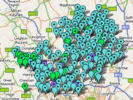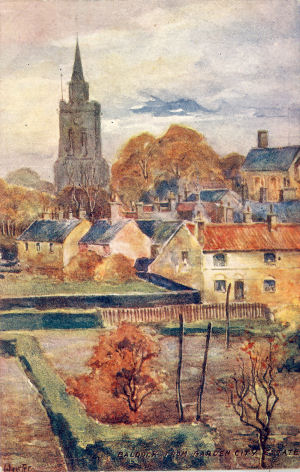|
The first reference to the town is to Baldoce
in 1135-54 and
The Place-names of Hertfordshire
records that "This town was founded by the Knights Templars in the 12th
century as shown in the statement in Dugdale 'in qua terra ipsi construxerunt
burgum qui dicitur Baudac.' Baldac is the Old French form for Baghdad
(Italian Baldacco), and Skeat rightly suggested that the place was named
by the Templars after the Arabian city. Ekwall notes that Manderville and
Skelton call Baghdad Baldak and Baldock. |
BALDOCK, a market town and parish in the
hundred of Broadwater, county of Hertford, 18 miles (N by W) from Hertford, and
37 ( N by W) from London, on the great north road, containing 1550 inhabitants.
This place, in the reign of Stephen, belonged to the Knights Templars, to whom
Gilbert, Earl of Pembroke, gave the site, which, in a charter of confirmation
granted by his descendant William, is called Baudoe, of which the present name
is a variation; though some antiquaries derive it from Balbec, supposing the
town to have been so called by the Templars, in memory of the city of that name
in Syria, from which their order had been expelled by the Saracens.
The town is situated near the intersection of
the Great North Road and the Roman Iknield-street, between two hills, which
command an extensive view of a fine open country: it consists principally of one
street, the houses in which are mostly ancient, interspersed with several of
modern erection, and is amply supplied with water. A Horticultural
society, patronised by the nobility and gentry in the neighbourhood, was
established in 1825. The trade is principally in malt, the land in the vicinity
being highly favourable to the growth of barley; the fens and marsh land near
the town form an extensive grazing district, and a great quantity of cheese of a
particular quality is made here; there is also a very large public brewery.
The general market, which was on Saturday, had
been discontinued, and a market, exclusively for the sale of straw-plat, is now
held on Friday. The fairs are on the festivals of St James, St Andrew, and St
Matthew, each continuing two days; at the last a great quantity of cheese is
sold.
The county magistrates hold a petty session on
the first Monday in every month: constables and other officers are appointed at
the court leet of the lord of the manor. The living is a discharged rectory, in
the archdeaconry of Huntingdon, and diocese of Lincoln, rated in the king's
books at £10. 8.9., endowed with £800 parliamentary grant, and in the
patronage of the Crown. The church, dedicated to St Mary, was built by the
Knights Templars, and nearly rebuilt in the early part of the fifteenth century:
it is a spacious structure, partly in the Norman style, and partly in the later
style of English architecture, with an octagonal steeple rebuilt a few years
ago, and contains a fine carved oak screen, part of the ancient rood-loft, and a
very curious font. There are places of worship for the Society of Friends,
Independents, and Wesleyan Methodists. Almshouses for twelve aged widows were
founded and endowed, in 1621, by Mr John Winne.
In cutting through Baldock Hill, to form a new
turnpike road, a great number of fossils, consisting of cornua ammonis, sharks'
teeth. &c., were discovered.
Topographical
Dictionary of England, 1831
|
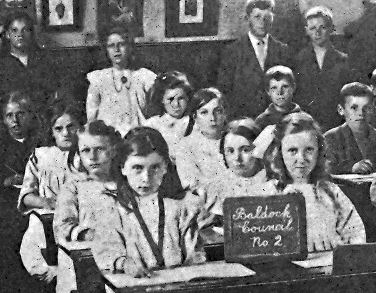
Pond Lane Council School
The enlargement shows a slate with the words
"Baldock Council No 2" |
For more information about the picture
of school girls see
Pond
Lane Council School, Baldock
In addition there was the Park Street
School, built 1832, for 125 boys, 117 girls & 120 infants; average
attendance, about 106 boys, 90 girls &70 infants. These schools are
endowed with the following bequests, viz. Mrs Mary Hindley's (1837) & Miss
Elizabeth Pryor's (1850), together amounting to £263 7s 2d. Miss Emma
Pryor's of £49 9s & H. O. Roe's £200, invested in 2¾
per cent Consols. Joseph V. Lloyd, master; Miss
Charlotte Annie Taylor, mistress; Miss Christopher, infants' mistress. The
children from Bygrave attend here. [Kelly's
Directory, 1912] |
|
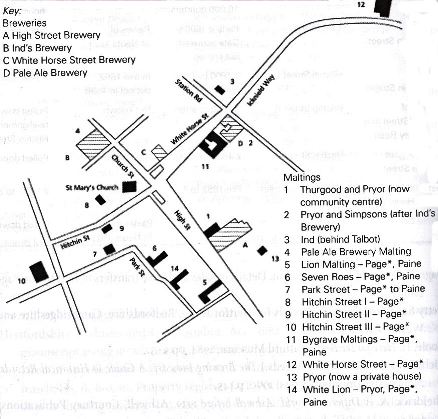
Breweries in Baldock |
There is extensive information on the
breweries in Baldock in the book
Brewers in Hertfordshire: A
historical gazetteer. It includes some very useful information,
including the map reproduced here.
Additional information, in answer to query
about William Penn, brewer of White Horse Street, is given on the page
the
Brewers and Malsters of Baldock, Early 19th Century.
See also
Whirlwind at
Baldock. Maltings seriously damaged.
Books
Maybe I have missed something but there
appears to be a dearth of books specifically on Baldock's history - although it is
regularly included in books covering the whole county and the lengthy historic
description in the
Victoria County History is available online. A check suggests that
there is little apart from the town guide, published at intervals by the local
council. I have not seen Edna Page's Baldock Voices: The Town as
Remembered by Baldock People, published in 1991 but I assume that it
concentrates on the 20th century.
My own index only
includes two items under Baldock.
Who
was Jack O' Legs relates to local legends and has little to offer
the family historian.
Tudor Churchwardens' Accounts
includes 16 pages transcribed from account books which have survived for the
period 1540-1553 which includes personal names, which could be of interest to
those searching that far back.
.Web Sites
Visit the
Baldock Museum web site for more information on the town's history,
etc.. The web page on St Mary the Virgin on
A Church
near You contains some pictures, but no history.
|
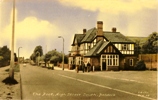
Boot, High Street S. |
Frith Postcards
circa 1950 |
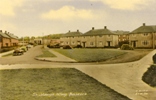
St Mary's Way |
|
|
|
|
|
November 2009 |
|
Restructured with menu |
|
February
2010 |
|
Postcard of
Old Cottage |
|
August 2016 |
|
Some
pictures moved to 1903 page |
